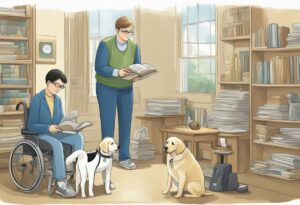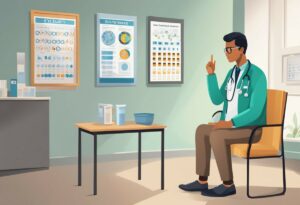In-Depth: An Unbiased Review of New Blindness Aids – Exploring the Latest Innovations

Navigating the world with a visual impairment can be challenging, but advancements in technology are continually providing new aids for the visually impaired and blind community. This article will provide an unbiased review of the latest tools designed to assist people with visual impairments in their daily activities and help them lead a more independent life. From smart mobility aids to state-of-the-art image processing techniques, these innovative technologies offer various solutions, meeting the unique needs of individuals with vision loss.
Recent studies have focused on developing and improving electronic travel aids (ETAs) that employ electromagnetic systems to guide visually impaired people during their journeys. Additionally, other technologies have emerged, such as “smart” aids that utilize various solutions to empower individuals with vision loss to travel independently and confidently. Researchers have explored different wayfinding tools and their effectiveness in facilitating safe navigation in various environments.
In this article, we will take an in-depth look at these new blindness aids, evaluating their effectiveness, usability, and adaptability. We will examine the advantages and drawbacks of each solution, providing an unbiased perspective on the available options for visually impaired individuals seeking to enhance their independence and overall quality of life. Stay tuned to learn more about the newest innovations that aim to improve the lives of those living with vision loss.
Understanding Blindness and Low Vision
Blindness and low vision are terms used to describe a wide range of visual impairments that affect an individual’s ability to see. These conditions can have a significant impact on a person’s daily life and activities, ranging from difficulty in reading and recognizing faces to the inability to perceive light.
Visual impairment refers to any decrease in visual acuity or visual field that affects a person’s ability to perform daily tasks. It can be caused by various factors, such as congenital or hereditary conditions, injury, or age-related diseases. Some common examples of visual impairments include:
- Retinitis pigmentosa: A group of genetic disorders that affect the retina’s ability to respond to light, causing a progressive loss of peripheral vision.
- Macular degeneration: A deterioration of the central area of the retina (macula), leading to a decline in central vision, essential for tasks like reading and driving.
- Diabetic retinopathy: A complication of diabetes that damages the blood vessels in the retina, causing vision loss over time.
- Cataracts: The clouding of the eye’s natural lens, which can result in blurred or distorted vision.
Legal blindness is a term used to describe a level of visual impairment severe enough to qualify a person for specific government benefits and services. In the United States, legal blindness is defined as having a visual acuity of 20/200 or worse in the better eye with the best possible correction (such as glasses or contact lenses) or having a visual field of 20 degrees or less.
Low vision, on the other hand, is a term used to describe visual impairments that cannot be fully corrected by standard glasses, contact lenses, or medical treatment. Individuals with low vision may still retain some degree of functional vision but may require specialized aids or adaptations to perform tasks and activities that people with normal vision can do without assistance.
In recent years, advances in technology have led to the development of various aids and devices that can significantly improve the quality of life for those living with blindness or low vision. These aids, which we will explore further in this article, are designed to help individuals overcome challenges related to mobility, communication, and various daily tasks.
Assistive Technology for Blindness
Assistive technology plays a crucial role in helping blind and visually impaired individuals lead more independent lives. There has been significant innovation in recent years, developing a range of tools and devices that make a difference to those affected by blindness.
One popular area is augmented reality, which can enhance the user’s perception of the physical environment by overlaying digital information to provide haptic cues, audio feedback, or spatial awareness. This technology can be used in conjunction with electronic orientation aids and electronic travel aids, allowing visually impaired people to navigate their surroundings more confidently.
Braille continues to be an essential tool for the blind community, with advancements such as refreshable braille displays that allow users to access digital content in braille format. Braille input devices, such as braille keyboards, make it easier for blind people to interact with various digital platforms.
Image processing, another important aspect of assistive technology for blindness, allows visual information to be converted into an accessible format. For example, Optical Character Recognition (OCR) software can read printed text aloud or convert it into a digital braille format. Similarly, object recognition and face detection technologies can provide audio descriptions of the nearby environment, helping visually impaired individuals understand their surroundings better.
Head-mounted displays and augmented vision systems are becoming increasingly popular, providing users with additional sensory information about their environment. These devices often incorporate electronic magnifiers, which enable users to zoom in on text or images, adjust contrast and brightness, and even change the color scheme to maximize visual comfort.
Low-vision aids include a variety of tools designed to enhance the remaining vision of those who are visually impaired. These aids range from simple handheld magnifiers to more sophisticated electronic devices that offer customizable settings for improved readability.
Haptic cues, such as vibrations or tactile feedback, are essential for many assistive devices. These cues can be especially useful in navigation systems, where blind or visually impaired users receive feedback through touch, allowing them to determine the correct direction or appraise obstacles in their path.
Overall, the assistive technology landscape for blindness is continually evolving, offering increased support and accessibility for those living with vision loss. By integrating features such as augmented reality, braille, image processing, head-mounted displays, electronic magnifiers, and haptic cues, these aids enable blind and visually impaired individuals to lead more independent and fulfilling lives.
Navigating the Environment
Visually impaired individuals rely on various tools and techniques to navigate their environment with confidence. These aids can help improve their independence, mobility, and overall quality of life.
One of the most common tools used for navigation by the visually impaired is the white cane. This simple yet effective device is essential for orientation and mobility, allowing the user to detect obstacles and safely walk without assistance. Proper training is crucial for individuals to maximize the benefits of using a white cane, as it requires mastering various techniques for efficient navigation.
Guide dogs are another popular option for many individuals with visual impairments. These specially trained service animals assist their handlers in avoiding obstacles, locating objects, and crossing streets safely. Obtaining a guide dog usually involves thorough training and assessment to ensure a successful partnership between the handler and the dog.
In addition to traditional aids like the white cane and guide dogs, advancements in technology have led to the development of innovative navigation tools for the visually impaired. For instance, smart canes are equipped with sensors to provide obstacle detection and other features that enhance user experience. Some smart canes can even connect to smartphone apps for better navigation and information access.
Wayfinding is another crucial aspect of navigating the environment for the visually impaired. Tactile maps and other resources can offer valuable information about the layout of a space, allowing individuals to plan their routes accordingly. When combined with orientation and mobility training, wayfinding tools can significantly improve an individual’s ability to navigate independently.
Additionally, there are mobility devices designed to aid those with low vision. These devices include binoculars and monoculars, which help visually impaired individuals see further and more clearly. These optical aids can enhance their ability to navigate by providing essential distance information about their surroundings.
In summary, a combination of traditional aids like the white cane and guide dogs, along with modern technologies such as smart canes and wayfinding tools, can significantly improve the ability of visually impaired individuals to navigate their environment independently. With proper training and access to these resources, individuals with visual impairments can confidently navigate the world around them.
Independent Living Skills
Independent living skills are crucial for individuals who are visually impaired, as these skills enable them to perform daily activities and become self-sufficient within their home and community. Various aids, devices, and services are available to help translate these skills into practical applications for blind and low-vision individuals.
One major aspect of independent living skills is communication. Assistive technology (AT) plays a significant role in facilitating communication for the visually impaired, with tools like screen readers, talking watches, and accessible smartphones. These devices allow for better interaction with others, fostering greater participation in school, community, and work.
Another essential aspect of independent living skills involves daily activities such as cooking, cleaning, and self-care. Various specialized household appliances and tools are designed for blind and low-vision users, offering both safety and efficiency. Devices such as contrast enhancement tools, tactile markers, and adaptive kitchen utensils provide valuable assistance.
Mobility improvement is a critical factor in promoting independence for visually impaired individuals. Canes, monocular telescopes, and electronic object detection systems aid in navigating safely in various environments, including obstacle courses and everyday navigation. These assistive tools ensure that visually impaired individuals can move confidently within their surroundings.
Having access to low vision services, including optical and non-optical aids, is crucial for maintaining or improving vision quality. Low vision clinics, optometrists, and vision rehabilitation services work together to provide comprehensive care and support to individuals with visual impairments. These services often conduct assessments to determine the best tools and techniques to overcome daily living challenges.
In addition, stand magnifiers, filter glasses, and illumination devices can enhance vision by improving focus, contrast, and magnification. Such tools are specifically designed to address the unique needs of visually impaired individuals, enabling them to perform daily tasks with greater ease.
In the area of recreation and leisure, various aids and adaptations allow visually impaired individuals to enjoy their interests and hobbies. From accessible sports equipment and tactile board games to adapted musical instruments and art supplies, these resources promote participation, skill development, and social connection.
Overall, the range of independent living aids available for blind and low-vision individuals supports their efforts to lead fulfilling lives in all aspects of daily living, education, and employment. By utilizing appropriate resources and assistive technology, those with visual impairments can maximize their potential for independence and self-confidence.
Addressing Specific Needs
When it comes to blindness aids, there is a wide variety of options available to cater to specific needs. This ensures that individuals with different types and levels of visual impairments find effective solutions for their unique challenges.
One group that faces specific challenges is those with deafblindness. Deafblindness refers to a combination of visual and auditory impairments, often requiring unique aids that address both sensory limitations. These individuals may benefit from touch-based communication systems, such as Tactile Signing or Haptic Communication, which allow them to effectively navigate their surroundings and engage in social interactions.
Medication can sometimes be prescribed to treat certain eye diseases causing vision loss. For instance, eyedrops or oral medications may help in managing glaucoma or age-related macular degeneration (AMD). While medication may not restore lost vision, it can slow down the progressing of these diseases and prevent further loss of vision.
For people with mild to moderate vision loss, conventional glasses and contact lenses are often the first line of defense. These corrective measures can significantly improve vision and help individuals with refractive errors like nearsightedness, farsightedness, or astigmatism to have better visual clarity. Glasses equipped with specialized lenses, such as magnifying or filter lenses, can also be useful for those with low vision.
In some cases, surgery may be a viable option to treat certain eye conditions causing vision impairment. Surgeries such as cataract removal, corneal transplantation, or retinal procedures can help restore or maintain functional vision for some individuals.
Developing an adaptive curriculum is essential to ensure individuals with visual impairments can access the educational content and learn effectively. This may involve incorporating assistive technology, accessible materials (e.g., large print or Braille), and modifications in the classroom environment to increase student engagement and learning.
Finally, it is important to recognize that several other blindness aid options exist beyond conventional glasses, contact lenses, or surgeries. These may include wearable devices, electronic magnifiers, or assistive technologies like screen readers, which can drastically improve the quality of life and independence for those with visual impairments. Offering a rich variety of options allows individuals to find personalized solutions that address their specific needs and challenges.
Frequently Asked Questions
What are the latest innovations in blindness aids?
Recent advancements in blindness aids include low vision glasses (also called wearables) and wayfinding tools. Wearable devices, such as smart glasses, can help visually impaired users navigate their environment by providing audio feedback or visual enhancements. Wayfinding tools use a combination of GPS and other technologies to guide users through indoor and outdoor spaces with audio cues or vibration alerts 1.
How do new technologies benefit users with glaucoma?
For people with glaucoma, technology aids can help in improving overall vision and maintaining daily activities. These aids can range from digital magnifiers, which enlarge text on screens, to wearable devices that provide real-time information about the environment. These tools can enhance the user’s ability to read, work, and engage in everyday tasks with greater ease and independence 2.
Which low vision aids are best for long reading sessions?
When it comes to long reading sessions, having a comfortable and effective low vision aid is essential. Devices such as electronic magnifiers or portable video magnifiers can help visually impaired users read for longer periods. They provide adjustable text size, contrast, and illumination, which can help reduce eye strain and improve overall reading experience 3.
What factors should be considered when selecting a magnifying glass for glaucoma?
When choosing a magnifying glass for glaucoma, consider factors such as magnification power, lens size, lighting options, and ease of use. Depending on the user’s visual needs and preferences, a handheld, stand, or wearable magnifying device might be most suitable. It is vital to find a magnifying glass that provides sufficient magnification and clarity while remaining easy to handle and operate 4.
How can reverse telescope low vision aids help those with visual impairment?
Reverse telescope low vision aids, or minifying lenses, can help individuals with visual impairment by reducing the size of the visual field. This can be beneficial for people with tunnel vision or restricted visual fields due to glaucoma or other eye conditions. By shrinking the image, reverse telescope aids can enable users to see more of their surroundings at once, improving orientation and mobility 5.
What are the pros and cons of various low vision aids?
Each low vision aid comes with its own set of advantages and disadvantages. Electronic magnifiers can provide adjustable text size, contrast, and illumination but may be more expensive than other options. Handheld magnifiers are portable and affordable but may require steady hands and can be tiring to use over time. Wearable devices offer hands-free operation and real-time environmental information but can be costly and take time for users to adapt to 6. Choosing the right aid depends on the user’s individual needs, preferences, and budget.
Footnotes
- https://www.frontiersin.org/articles/10.3389/feduc.2021.723816/full ↩
- https://journals.sagepub.com/doi/10.1177/0264619618814071 ↩
- https://www.ncbi.nlm.nih.gov/pmc/articles/PMC9324285/ ↩
- https://www.diva-portal.org/smash/get/diva2:1241276/FULLTEXT01.pdf ↩
- https://www.frontiersin.org/articles/10.3389/feduc.2021.723816/full ↩
- https://www.ncbi.nlm.nih.gov/pmc/articles/PMC9324285/ ↩



